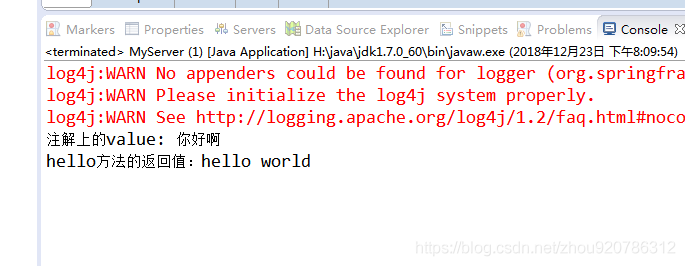版权声明:本文为博主原创文章,未经博主允许不得转载。 https://blog.csdn.net/zhou920786312/article/details/85225679
代码
注解
@Target({ ElementType.TYPE })//注解用在接口上
@Retention(RetentionPolicy.RUNTIME)//VM将在运行期也保留注释,因此可以通过反射机制读取注解的信息
@Component
public @interface RpcService {
String value();
}
-----
使用注解
public interface HelloService {
String hello(String name);
}
@RpcService("你好啊")
public class HelloServiceImpl implements HelloService {
public String hello(String name) {
return name;
}
}
测试类
@Component //ApplicationContextAware会为Component组件调用setApplicationContext方法; 测试Myserver3时注释
public class Test implements ApplicationContextAware {
@SuppressWarnings("resource")
public static void main(String[] args) {
ClassPathXmlApplicationContext ctx = new ClassPathXmlApplicationContext("spring2.xml");
}
public void setApplicationContext(ApplicationContext ctx)throws BeansException {
//获取被注解标准的bean
Map<String, Object> serviceBeanMap = ctx.getBeansWithAnnotation(RpcService.class);
for (Object serviceBean : serviceBeanMap.values()) {
try {
//获取自定义注解上的value
String value = serviceBean.getClass().getAnnotation(RpcService.class).value();
System.out.println("注解上的value: " + value);
//反射被注解类,并调用指定方法
Method method = serviceBean.getClass().getMethod("hello",new Class[] { String.class });
Object invoke = method.invoke(serviceBean, "hello world");
System.out.println("hello方法的返回值:"+invoke.toString());
} catch (Exception e) {
e.printStackTrace();
}
}
}
}配置和项目截图

结果:
